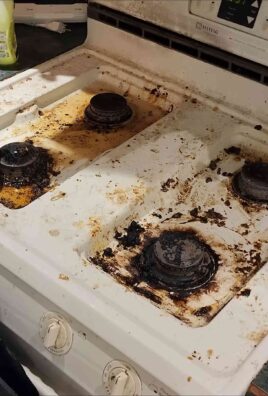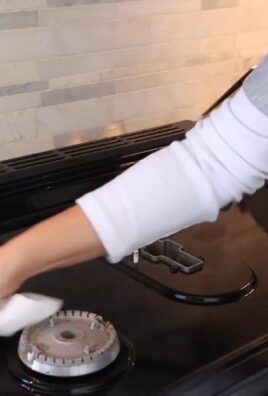Fast kitchen deep cleaning tricks – who doesn’t crave them? Let’s be honest, the kitchen, the heart of our homes, often bears the brunt of daily life. From splattered sauces to lingering odors, it can quickly transform from a culinary haven to a cleaning battlefield. But fear not, fellow home cooks and busy bees! I’m here to share some game-changing DIY secrets that will have your kitchen sparkling in no time, without sacrificing your precious weekend.
For generations, a clean kitchen has been synonymous with a healthy and happy home. Think back to your grandmother’s meticulously kept kitchen, a testament to her care and dedication. While we may not have the luxury of spending hours scrubbing, we can certainly adopt her wisdom and apply it to our modern lives. These fast kitchen deep cleaning tricks aren’t just about aesthetics; they’re about creating a hygienic space where you can confidently prepare meals for yourself and your loved ones.
In today’s fast-paced world, time is of the essence. Nobody wants to spend an entire day scrubbing grout or battling stubborn grease. That’s why these DIY hacks are so essential. They’re designed to be quick, effective, and use ingredients you likely already have in your pantry. So, ditch the harsh chemicals and embrace these simple, yet powerful, methods to reclaim your kitchen and your time!

Fast Kitchen Deep Cleaning Tricks: My Go-To Guide
Okay, let’s be honest, deep cleaning the kitchen is nobody’s favorite chore. But a sparkling clean kitchen makes cooking and eating so much more enjoyable! I’ve developed a system over the years to tackle this beast quickly and efficiently. Here’s my tried-and-true guide to a fast kitchen deep clean, broken down into manageable steps.
Phase 1: Prep and Gather Your Arsenal
Before you even think about scrubbing, you need to get organized. Trust me, this saves time in the long run.
* Gather Your Supplies: I like to keep everything in a caddy for easy transport. Here’s what I usually include:
* All-purpose cleaner (I prefer a natural, citrus-based one)
* Dish soap
* Baking soda
* White vinegar
* Microfiber cloths (lots of them!)
* Scrub brush
* Sponges (one for general cleaning, one for tougher grime)
* Old toothbrush (for those hard-to-reach spots)
* Rubber gloves (protect those hands!)
* Trash bags
* Paper towels
* Glass cleaner
* Oven cleaner (if needed)
* Stainless steel cleaner (if applicable)
* Magic Eraser (for stubborn marks)
* A bucket of hot, soapy water
* Clear the Decks: Remove everything from your countertops. Seriously, everything. This includes appliances, canisters, utensils, and anything else that’s cluttering up the space. Put it all on the dining table or another clear surface. This gives you a blank canvas to work with.
* Empty the Sink: Get rid of any dirty dishes lurking in the sink. Load them into the dishwasher or wash them by hand. A clean sink is essential for the cleaning process.
* Open Windows: Ventilation is key, especially when using cleaning products. Open windows and doors to circulate fresh air.
Phase 2: Tackling the Big Stuff
Now that you’re prepped, let’s dive into the areas that usually take the most time.
1. Oven Cleaning (While You Do Other Things!)
This is where the “fast” part comes in. We’re going to use a little trick to make oven cleaning less of a chore.
1. Preheat and Spray (Optional): If your oven is heavily soiled, you can preheat it to a low temperature (around 200°F) for about 15 minutes. Then, turn it off and let it cool slightly. This helps loosen baked-on grime. Then spray with oven cleaner.
2. Baking Soda Paste (My Preferred Method): Alternatively, and my preferred method, create a paste of baking soda and water. It should be thick enough to spread easily.
3. Apply the Paste: Spread the baking soda paste generously over the entire interior of the oven, avoiding the heating elements. Pay special attention to areas with baked-on food.
4. Let it Sit: This is the magic part! Let the baking soda paste sit for at least 3 hours, or even better, overnight. The longer it sits, the easier it will be to remove the grime.
5. Wipe Away: After the soaking time, use a damp sponge or cloth to wipe away the baking soda paste. You may need to scrub a bit in stubborn areas.
6. Vinegar Rinse: Fill a spray bottle with white vinegar and spray the inside of the oven. The vinegar will react with any remaining baking soda, creating a fizzing action that helps loosen any remaining residue.
7. Final Wipe Down: Wipe the oven clean with a damp cloth. Repeat as needed until all traces of baking soda and vinegar are gone.
8. Dry and Admire: Dry the oven with a clean cloth.
2. Refrigerator Refresh
A clean fridge is a happy fridge!
1. Empty the Fridge: Remove all food items from the refrigerator. Check expiration dates and discard anything that’s spoiled or past its prime.
2. Remove Shelves and Drawers: Take out all removable shelves, drawers, and bins.
3. Wash Shelves and Drawers: Wash the shelves, drawers, and bins with hot, soapy water. Rinse thoroughly and let them air dry.
4. Wipe Down Interior: Wipe down the interior of the refrigerator with a solution of warm water and baking soda. This helps to neutralize odors and remove stains.
5. Clean Door Seals: Don’t forget the door seals! Use a damp cloth to wipe them clean.
6. Replace Shelves and Drawers: Once the shelves and drawers are dry, replace them in the refrigerator.
7. Restock the Fridge: Put the food items back into the refrigerator, organizing them as you go. Place older items in the front and newer items in the back.
8. Odor Absorber (Optional): Place an open box of baking soda or a container of activated charcoal in the refrigerator to absorb odors.
3. Dishwasher Deep Clean
Your dishwasher works hard, so it deserves some love too!
1. Remove Food Debris: Check the drain at the bottom of the dishwasher and remove any food debris that may be clogging it.
2. Vinegar Cycle: Place a dishwasher-safe cup filled with white vinegar on the top rack of the dishwasher.
3. Run a Hot Cycle: Run the dishwasher on a hot cycle without any dishes. The vinegar will help to remove grease, grime, and odors.
4. Baking Soda Boost (Optional): After the vinegar cycle, sprinkle a cup of baking soda on the bottom of the dishwasher and run another short cycle. This will further freshen the dishwasher.
5. Clean the Exterior: Wipe down the exterior of the dishwasher with a damp cloth.
Phase 3: Countertops, Sink, and Backsplash
These are the areas you use most often, so let’s get them sparkling.
1. Countertop Cleaning:
* Spray and Wipe: Spray your countertops with all-purpose cleaner and let it sit for a few minutes to loosen any grime.
* Scrub (If Needed): If there are any stubborn stains, use a scrub brush or a Magic Eraser to gently scrub them away.
* Wipe Clean: Wipe the countertops clean with a damp microfiber cloth.
* Dry: Dry the countertops with a clean cloth.
2. Sink Scrubbing:
* Rinse: Rinse the sink with water to remove any loose debris.
* Baking Soda Scrub: Sprinkle baking soda over the entire sink surface.
* Scrub: Use a scrub brush or sponge to scrub the sink, paying special attention to the drain and faucet areas.
* Rinse: Rinse the sink thoroughly with water.
* Vinegar Shine: Spray the sink with white vinegar and let it sit for a few minutes. This will help to remove any water spots and leave the sink sparkling.
* Rinse and Dry: Rinse the sink again with water and dry it with a clean cloth.
3. Backsplash Brilliance:
* Spray and Wipe: Spray the backsplash with all-purpose cleaner and let it sit for a few minutes.
* Wipe Clean: Wipe the backsplash clean with a damp microfiber cloth.
* Dry: Dry the backsplash with a clean cloth.
Phase 4: Floors and Finishing Touches
Almost there! Let’s finish strong.
1. Sweep or Vacuum: Sweep or vacuum the kitchen floor to remove any loose dirt and debris.
2. Mop the Floor: Mop the floor with a solution of warm water and all-purpose cleaner.
3. Clean Small Appliances: Wipe down the exterior of your small appliances, such as the toaster, blender, and coffee maker.
4. Clean Cabinet Fronts: Wipe down the fronts of your kitchen cabinets with a damp cloth to remove any grease or fingerprints.
5. Polish Stainless Steel: If you have stainless steel appliances, use a stainless steel cleaner to polish them and remove any smudges.
6. Empty the Trash: Take out the trash and replace the trash bag.
7. Put Everything Back: Return all the items you removed from the countertops to their designated places.
8. Enjoy Your Sparkling Kitchen! Take a step back and admire your hard work. You deserve it!
Bonus Tip: Maintaining the Sparkle
The key to keeping your kitchen clean is to maintain it regularly. Here are a few tips:
* Wipe up spills immediately.
* Wash dishes after each meal.
* Wipe down countertops daily.
* Sweep the

Conclusion
So, there you have it! These fast kitchen deep cleaning tricks aren’t just about achieving a sparkling clean kitchen; they’re about reclaiming your time, reducing stress, and creating a healthier, more enjoyable cooking environment. We’ve explored simple yet incredibly effective methods, from harnessing the power of baking soda and vinegar to decluttering strategically and tackling those often-overlooked areas.
Why is this a must-try? Because a clean kitchen is more than just aesthetically pleasing. It’s a space where you can experiment with new recipes, gather with loved ones, and nourish your body without the nagging feeling of lingering grime. It’s about creating a sanctuary where culinary creativity can flourish.
But don’t just take our word for it. The real magic happens when you put these techniques into practice. Start small, perhaps with just one or two of the tricks, and witness the immediate impact. You’ll be amazed at how quickly you can transform your kitchen from a source of stress into a source of pride.
Looking for variations? Absolutely! For stubborn grease stains on your stovetop, try adding a few drops of dish soap to your baking soda paste. For a refreshing scent, infuse your vinegar cleaning solution with citrus peels. And if you’re short on time, focus on the high-traffic areas like the sink and countertops. Remember, even a quick 15-minute cleaning session can make a significant difference.
We encourage you to embrace these fast kitchen deep cleaning tricks and make them a regular part of your routine. Not only will you enjoy a cleaner, more organized kitchen, but you’ll also experience a sense of accomplishment and control over your living space.
Now, we want to hear from you! Have you tried any of these methods? Do you have your own secret weapon for keeping your kitchen sparkling? Share your experiences, tips, and tricks in the comments below. Let’s create a community of clean kitchen enthusiasts and inspire each other to maintain a healthy and happy home. Your insights could be invaluable to someone else struggling with kitchen clutter and grime. So, go ahead, give these tricks a try, and let us know how they work for you. We’re confident that you’ll be amazed by the results!
Frequently Asked Questions (FAQ)
Q: How often should I deep clean my kitchen?
A: The frequency of deep cleaning depends on how often you cook and the level of activity in your kitchen. As a general guideline, aim for a deep clean every 1-3 months. However, if you cook frequently or have a large family, you might want to deep clean more often. Regular maintenance, such as wiping down surfaces after each use and sweeping or mopping the floor weekly, can help extend the time between deep cleans.
Q: What’s the best way to clean a greasy oven?
A: Cleaning a greasy oven can be a daunting task, but here’s a simple and effective method:
1. Remove oven racks and soak them in hot, soapy water.
2. Make a paste of baking soda and water (about 1/2 cup baking soda to 2-3 tablespoons of water).
3. Spread the paste all over the inside of the oven, avoiding the heating elements.
4. Let the paste sit overnight (or for at least 12 hours).
5. The next day, wipe out the paste with a damp cloth. You may need to scrub a bit for stubborn areas.
6. Rinse the oven thoroughly with clean water.
7. Clean the oven racks and return them to the oven.
For extremely greasy ovens, you can add a few drops of dish soap to the baking soda paste.
Q: How can I get rid of stubborn stains on my countertops?
A: The best approach depends on the type of countertop you have. For granite or marble, avoid using acidic cleaners like vinegar or lemon juice, as they can damage the surface. Instead, use a pH-neutral cleaner specifically designed for stone countertops. For laminate countertops, you can try a paste of baking soda and water or a solution of mild dish soap and water. For stubborn stains, let the paste or solution sit for a few minutes before wiping it away. Always test any cleaning solution in an inconspicuous area first to ensure it doesn’t damage the countertop.
Q: What’s the best way to clean my kitchen sink?
A: The best method depends on the material of your sink. For stainless steel sinks, you can use a paste of baking soda and water to scrub away stains and grime. Rinse thoroughly with water and dry with a clean cloth to prevent water spots. For porcelain sinks, avoid using abrasive cleaners, as they can scratch the surface. Instead, use a mild dish soap and water or a non-abrasive cleaner specifically designed for porcelain. For cast iron sinks, you can use a similar approach as porcelain, but be sure to dry the sink thoroughly after cleaning to prevent rust.
Q: How can I declutter my kitchen effectively?
A: Decluttering your kitchen can seem overwhelming, but here’s a step-by-step approach:
1. Start by taking everything out of one cabinet or drawer.
2. Sort through the items and get rid of anything you don’t use, need, or love.
3. Organize the remaining items in a way that makes sense for you.
4. Repeat the process for each cabinet and drawer in your kitchen.
5. Consider donating or selling items that are still in good condition.
Focus on getting rid of duplicates, expired food, and items you haven’t used in months.
Q: How can I prevent my kitchen from getting dirty so quickly?
A: Prevention is key! Here are a few tips:
* Wipe down surfaces after each use.
* Clean up spills immediately.
* Sweep or mop the floor regularly.
* Wash dishes promptly.
* Empty the trash can frequently.
* Declutter regularly to prevent buildup.
* Use placemats and coasters to protect countertops.
By incorporating these simple habits into your daily routine, you can significantly reduce the amount of time and effort required for deep cleaning.
Q: Are there any natural alternatives to harsh chemical cleaners?
A: Absolutely! Many natural ingredients can be used to effectively clean your kitchen. Baking soda, vinegar, lemon juice, and essential oils are all excellent choices. For example, vinegar can be used to clean countertops, floors, and appliances. Lemon juice can be used to disinfect cutting boards and remove stains. Essential oils can be added to cleaning solutions for a pleasant scent and added antibacterial properties. Always research the best uses for each natural cleaner and test in an inconspicuous area first.
Q: How do I clean my microwave effectively?
A: A simple and effective way to clean your microwave is to microwave a bowl of water with lemon slices or vinegar for a few minutes. The steam will loosen any stuck-on food, making it easy to wipe clean. Be careful when removing the bowl, as it will be hot.
Q: What are some often-overlooked areas in the kitchen that need cleaning?
A: Some often-overlooked areas include:
* Inside the refrigerator (shelves, drawers, and door compartments)
* Underneath appliances (stove, refrigerator, dishwasher)
* Behind the stove and refrigerator
* The grout between tiles
* The inside of the dishwasher
* The range hood filter
* Light fixtures
Don’t forget to clean these areas during your deep cleaning sessions!





Leave a Comment